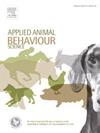Examining time sampling schemes for quantifying pullet and hen behavior
IF 2.2
2区 农林科学
Q1 AGRICULTURE, DAIRY & ANIMAL SCIENCE
引用次数: 0
Abstract
Within poultry science, a variety of behavioral observation sampling methods have been used. Although the method for determining the acceptability of a chosen time sampling strategy should be provided, the reasoning behind the selection of a specific sampling strategy is seldom explained in publications. A previous study provided a framework for validating behavioral sampling schemes for adult laying hens. Rather than utilizing this framework, some researchers have used the results of the published time sample validation to justify their sampling scheme. However, the results may not be generalizable due to sample size limitations. Application of previously validated time sampling methods to new research contexts may be particularly problematic when a validation is completed on older birds but applied to other ages. This is due to developmentally relevant differences in activity levels and resource use. We examined the appropriateness of different interval scan sampling durations for estimating resource use by laying hen pullets reared in a single-platform aviary system. We hypothesized that younger birds would be more active, and therefore more frequent sampling would be needed to accurately capture their location within the aviary during the day. Dekalb White pullets were reared in 4 pens (55 per pen). Using continuous observations, we identified the location (floor, perch, ramp and platform) of each of 20 individually marked focal birds (5 pullets/pen) at 6 and 12 weeks of age. Observations were carried out on one of two days within each week (half of the pens observed on each day), for a total of 6 hours per day. We conducted pairwise comparisons between the actual frequencies of resource use (continuously sampled data converted into 1-s interval data) and data representing 1, 5, 10, 15, and 30 min scan intervals. Scan sampling intervals were deemed to be accurate if 3 criteria were met: the slope of the regression between the actual and estimated values did not differ from 1 (P > 0.05), the intercept did not differ from 0 (P > 0.05), and the association among the actual and estimated values was strong. The Benjamini-Hochberg adjustment was applied to account for multiple testing on the same data. The results demonstrate that different sampling intervals are appropriate for different resources and ages. The study highlights the necessity of validating behavioral sampling schemes for each age and behavior independently, as well as reporting the validation process in research publications.
求助全文
约1分钟内获得全文
求助全文
来源期刊

Applied Animal Behaviour Science
农林科学-行为科学
CiteScore
4.40
自引率
21.70%
发文量
191
审稿时长
18.1 weeks
期刊介绍:
This journal publishes relevant information on the behaviour of domesticated and utilized animals.
Topics covered include:
-Behaviour of farm, zoo and laboratory animals in relation to animal management and welfare
-Behaviour of companion animals in relation to behavioural problems, for example, in relation to the training of dogs for different purposes, in relation to behavioural problems
-Studies of the behaviour of wild animals when these studies are relevant from an applied perspective, for example in relation to wildlife management, pest management or nature conservation
-Methodological studies within relevant fields
The principal subjects are farm, companion and laboratory animals, including, of course, poultry. The journal also deals with the following animal subjects:
-Those involved in any farming system, e.g. deer, rabbits and fur-bearing animals
-Those in ANY form of confinement, e.g. zoos, safari parks and other forms of display
-Feral animals, and any animal species which impinge on farming operations, e.g. as causes of loss or damage
-Species used for hunting, recreation etc. may also be considered as acceptable subjects in some instances
-Laboratory animals, if the material relates to their behavioural requirements
 求助内容:
求助内容: 应助结果提醒方式:
应助结果提醒方式:


